Top 33 COMMON BIRDS In North Carolina (ID Guide With Photos)
Did you recently come across a familiar bird in North Carolina, and want to know what species it was?
Bird identification in North Carolina is not as easy as it might seem, since there are many bird species in the Old North state that look similar.
To help you identify the bird you saw, we’ll cover the most common birds of North Carolina in this article, and where to find them.

What are the most common birds found in North Carolina?
The 33 most common birds found in North Carolina are:
- Northern Cardinal
- American Robin
- Northern Mockingbird
- House Sparrow
- American Goldfinch
- Mourning Dove
- Blue Jay
- American Crow
- House Finch
- European Starling
- Red-winged Blackbird
- Common Grackle
- Red-bellied Woodpecker
- Downy Woodpecker
- Hairy Woodpecker
- Carolina Wren
- Ruby-throated Hummingbird
- House Wren
- Yellow-rumped Warbler
- Eastern Phoebe
- Gray Catbird
- Tufted Titmouse
- Barn Swallow
- Yellow-throated Warbler
- Eastern Towhee
- Carolina Chickadee
- Eastern Bluebird
- Indigo Bunting
- White-throated Sparrow
- Dark-eyed Junco
- White-breasted Nuthatch
- Song Sparrow
- Chipping Sparrow
While many of these species of birds are found year-round in North Carolina, some are migratory birds that only occur in the Old North state during the summer.
Now let’s dive into the details, and take a closer look at each of these common species in order to get the full scoop:
Northern Cardinal
Scientific name: Cardinalis cardinalis
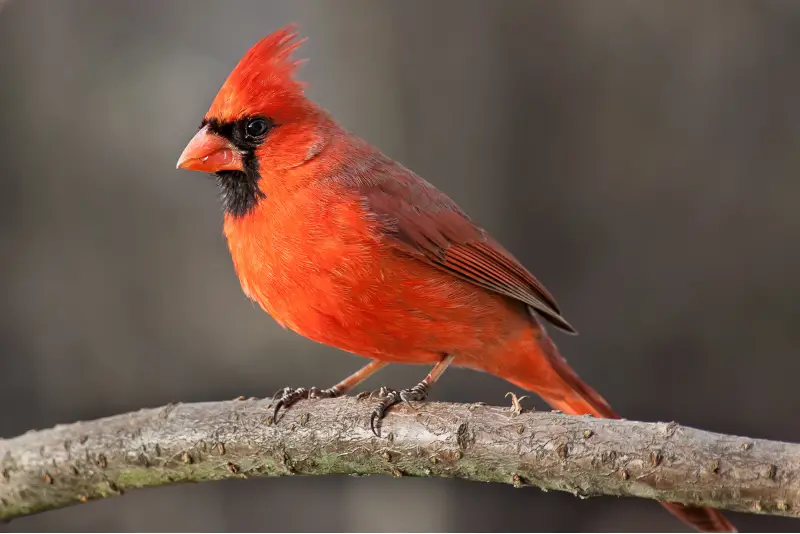
As the state bird of North Carolina, the Northern Cardinal is perhaps the most well known red bird in North Carolina.
Male Northern Cardinals have a bright crimson red coloration on their head, chest, and belly, and slightly darker red on their back and wing feathers.
In addition, the face has a black mask extending from the bright red bill to the throat.
Female Northern Cardinals are not quite as colorful as males, and have a more buff-brown body color with some reddish tinges, although they also have a bright red bill.
The Northern Cardinal is a common backyard bird in North Carolina, and can be seen year round in backyards, small forests, and parks.
During the winter months it doesn’t defend its territory, and sometimes gathers in flocks of up to 25 individuals that feed together. The Northern Cardinal is a regular visitor at bird feeders.
American Robin
Scientific name: Turdus migratorius
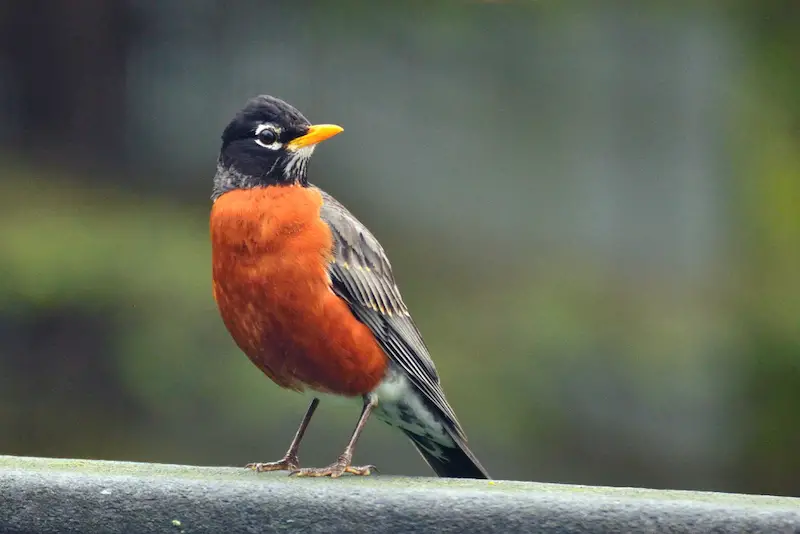
The American Robin is actually a thrush, but got its name from early settlers in North America who noticed its resemblance with the European Robin.
The orange chest of the American robin makes it easy to identify this type of bird. It mostly forages for food on the ground with the help of its powerful legs and stout yellow beak.
In the fall and winter, it feeds on fruit and searches for snails and worms amid the fallen leaves. It frequently congregates in big roosts in the non-breeding season.
The American Robin is a superb singer, with a song that is melodious and flowing, similar to many other thrushes.
They construct their bulky nests out of twigs at a very variable height, from the ground all the way up to the canopy of the trees.
In a typical year, American robins will have between two and three broods.
While the original habitat of American Robins was woodlands, they have adjusted superbly to the expansion of human settlements, and are now found in suburban areas as common breeding birds.
This thrush is a partial migratory bird, with its northernmost populations in Canada and the northern USA being entirely migratory.
In North Carolina, the American Robin is found all year round, and likes to form flocks that roost together during the winter.
Northern Mockingbird
Scientific name: Mimus polyglottos
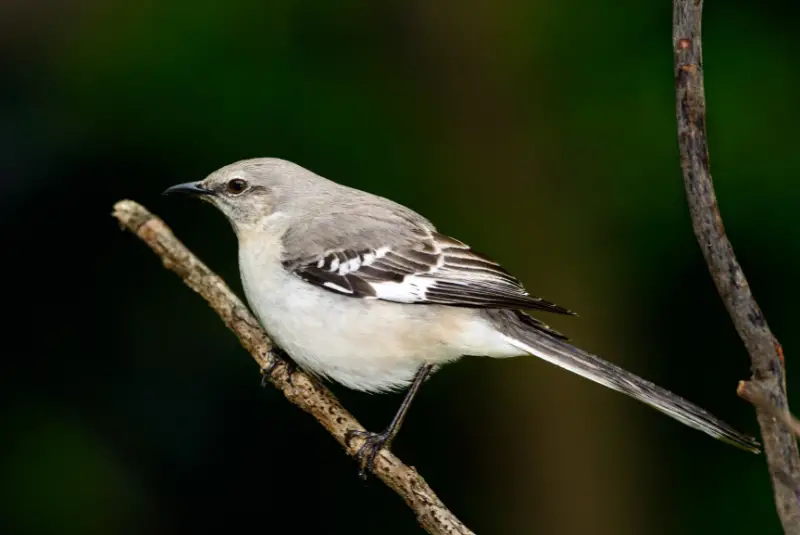
The Northern Mockingbird is a familiar songbird in North Carolina, and its melodious whistling song can be heard in many parts of the state.
Its overall appearance is dark gray, except for its black wings with white stripes, which are especially conspicuous in flight, flashing like bright signals.
It is a common backyard bird in North Carolina, with both sexes resembling each other. In addition to the black wings, the tail is also black, and has white margins.
It has a dark eyestripe that contrasts with the yellow eye, while the underparts are buff white. Juvenile birds look similar to adults, but are covered with spots and streaks.
The Northern Mockingbird is a common songbird, and a year-round resident in North Carolina. It is also a summer visitor in the northernmost states as well as Canada.
This bird is the only mockingbird species found in North America. It prefers wooded areas as well as urban habitats with sufficient tree growth, such as parks and golf courses.
House Sparrow
Scientific name: Passer domesticus
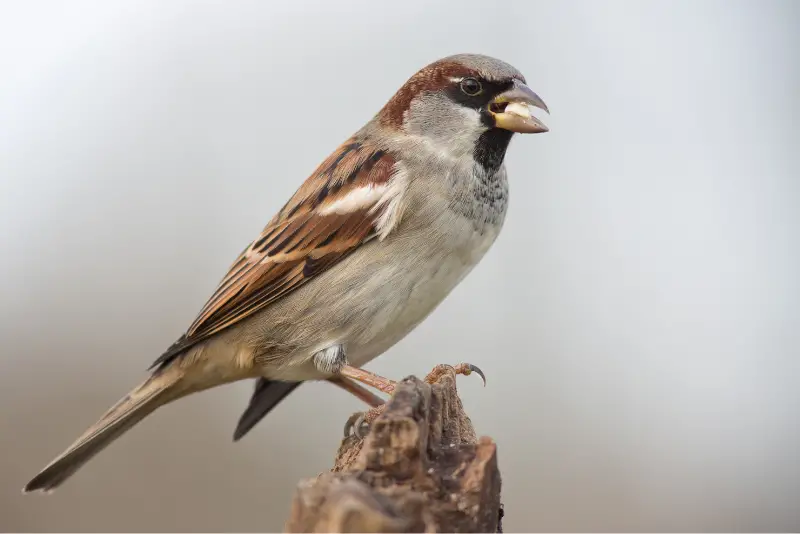
The House Sparrow is a familiar urban songbird in North Carolina.
Adult males have upperparts that are primarily chestnut brown with dark streaks. The wings are chestnut brown with a white wingbar.
A great characteristic to identify males is by their gray crown and rump. Females are more drab, and are mostly buff gray with dark streaks on their back.
The House Sparrow is not a native bird of the Old North state, but was introduced by European settlers.
However it has successfully colonized the entire North American continent, and is now a common urban bird that is found in parks and backyards.
American Goldfinch
Scientific name: Spinus tristis
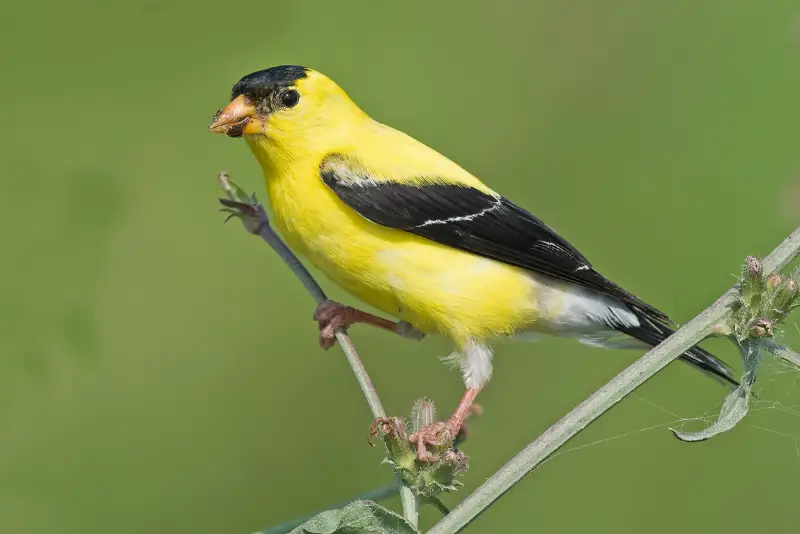
The American Goldfinch is easily recognizable yellow bird in North Carolina due to its distinctive bright coloration.
Adult males have almost entirely bright yellow plumage, except for a black cap, black wings, and a black tail.
This is the most common yellow bird found in North Carolina
Females are not as brightly colored, but are more buff yellowish-brown with black wings.
It is a common year-round breeding bird in the Old North state, and a regular visitor at bird feeders offering sunflower seeds.
During the winter months, it forms flocks that forage together, feeding on thistles in weedy fields.
Mourning Dove
Scientific name: Zenaida macroura
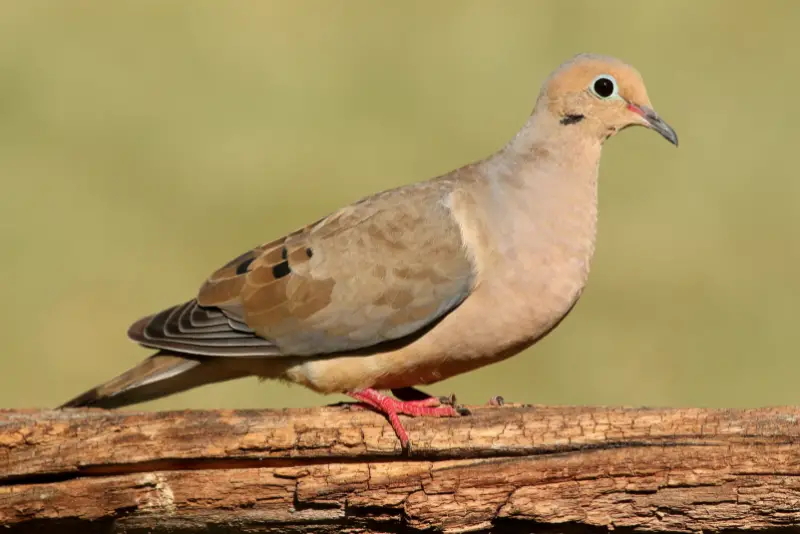
The Mourning Dove is one of the most common birds in North America, especially around farms and suburban areas.
This bird is almost entirely grayish-brown with a pale underside. The wings and the tail are pointed, and there is a small black dot on the side of the face.
When viewed up close, a grayish blue eyering as well as pink legs and toes are great distinguishing features of the Mourning Dove.
It is a common dove in North Carolina, and can be seen year-round. During the winter it also frequents open woodland, but avoids large forests.
Blue Jay
Scientific name: Cyanocitta cristata
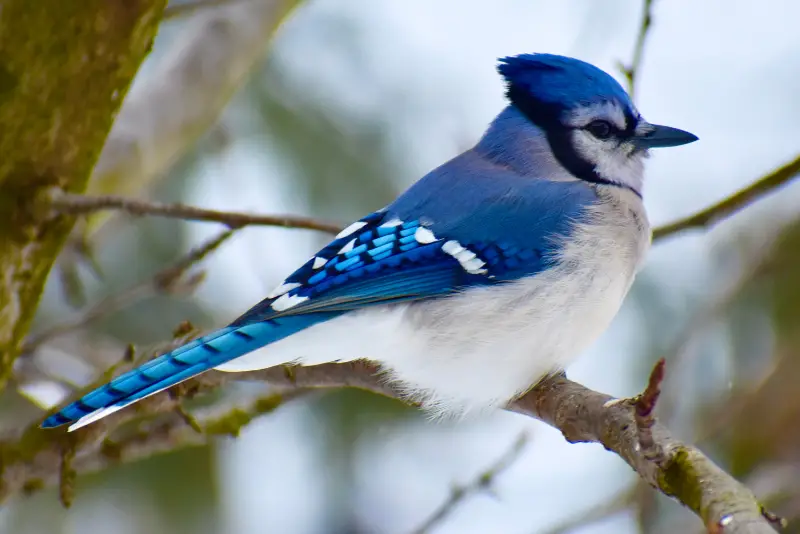
A common blue-colored bird, the Blue Jay prefers open areas with scattered trees, shrubs, and other vegetation with dense undergrowth.
These medium-sized birds are grayish blue on top, with bright arctic blue wing feathers and tail feathers. Their underparts are light gray.
They are social birds that live in small groups called colonies, with each colony containing one dominant pair and several subordinate members.
Dominant male birds defend their territory against intruders and aggressively chase away subordinates. Subordinate females and young birds are tolerated but not protected.
These blue backyard birds are opportunistic feeders. They eat fruit, invertebrates, small vertebrates, and carrion, and also steal food from other animals.
During the summer, insects make up the largest part of their diet. They sometimes catch insects in flight, while at other times, they catch insects at ground level using a variety of techniques.
These blue birds of North Carolina often use man made structures such as buildings, bridges, and telephone poles for foraging.
When hunting for food, jays often run along branches or wires before swooping down to capture prey.
They are partially migratory birds, but can be seen in central North Carolina all year round. During the cold season they sometimes move around to areas with a more plentiful supply of food.
If you want to attract these birds to your bird feeder, it’s best to offer them peanuts or sunflower seeds.
American Crow
Scientific name: Corvus brachyrhynchos
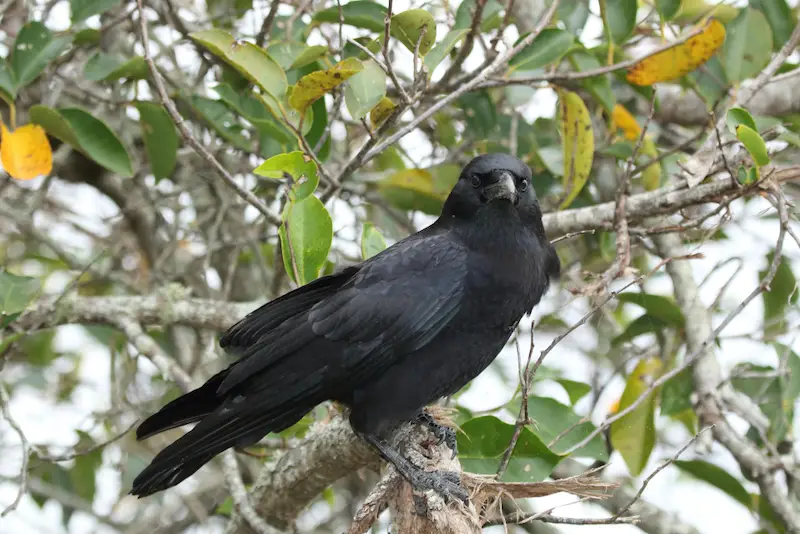
This is a common and easily recognizable black-colored bird in North Carolina.
This is one of the most intelligent birds in the world. It also happens to be one of the most sociable, and it likes to pass the time by harassing other birds.
American Crows are large North Carolina birds that are entirely black, including black beaks, legs, and eyes.
In fact, both adults and immature birds are completely black, and hard to distinguish from each other. Family groups of crows sleep together at night but split off during the day to go foraging.
Similar to vultures and birds of prey, American Crows like to feed on roadkill, but rarely get hit by cars themselves.
Outside of the breeding season, this bird forms massive flocks, sometimes topping out at thousands of birds.
The American Crow builds a big stick nest in trees, which it likes to reuse for many years. Old crows nests are also used by many other birds, including raptors and North Carolina owls.
American Crows are common in North Carolina in open forests and woodlands, as well as farmland and urban areas such as parks, golf courses, and large gardens.
House Finch
Scientific name: Haemorhous mexicanus
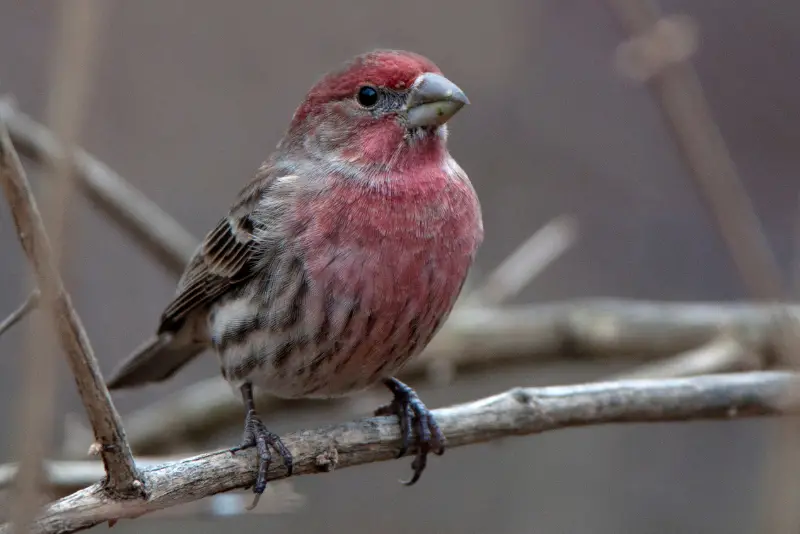
The House Finch is a common small bird in North Carolina, and is mostly found in settled areas, ranging from small towns to large metropolitan centers.
Adult male House Finches can be identified by the bright red feathers on the head and upper breast, although in some cases they are slightly more orange or yellowish in color.
The females lack any red coloration, and instead have grayish streaks on a brown background.
The House Finch was originally a western bird, and it wasn’t until the 1940s that this bird was discovered in New York and other places on the east coast of the US.
The eastern House Finch population began to grow in the 1950s and 60s, and by the year 2000, it had expanded so far west that it connected with the original western population.
The House Finch is entirely herbivorous, and feeds on seeds, buds, and fruits.
If you set up a bird feeder in your backyard, you can expect House Finches to be among the first birds to visit it.
The House Finch is found in North Carolina all year round, and while it is not a migratory bird, it does move to areas with more food outside of the breeding season.
European Starling (Common Starling)
Scientific name: Sturnus vulgaris
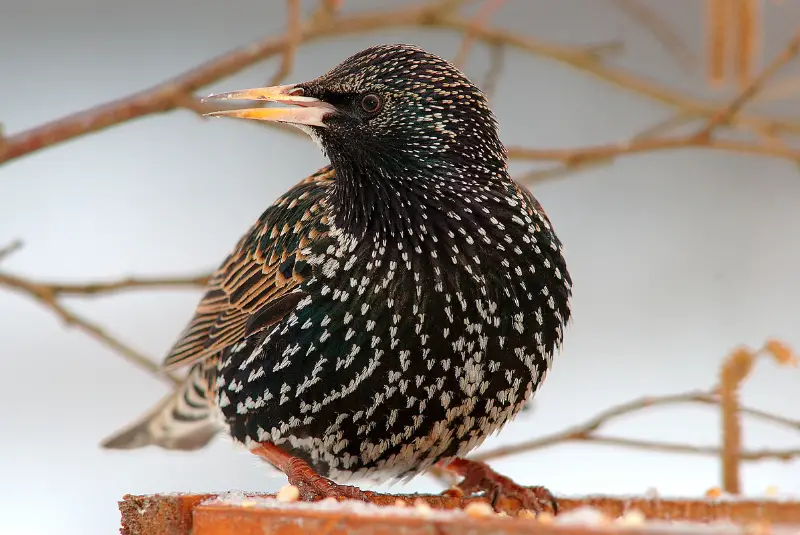
The Common Starling (also known as European Starling) is a common backyard bird in the Old North state. Adult Common Starlings are uniformly black with a glossy sheen.
During winter, the black feathers of Common Starlings are covered with light spots, which can be a great characteristic to identify them.
This species is originally from Europe, Asia, and North Africa, but it was introduced to North America and many other parts of the world, where this bird has established itself as a successful breeding species within a short period of time.
Common Starlings inhabit open country with few trees as their original habitat, but they are also among the most successful urban birds, and are especially common in parks and gardens.
While Common Starlings nest in tree holes in the wild, they are also known to nest inside buildings and nest boxes in urban settings.
Unfortunately, native birds are sometimes driven out of their nesting sites by competing Starlings.
Similar to grackles and other blackbirds, Common Starlings form large flocks outside of the nesting season.
These flocks can contain more than a million individuals, and can be seen performing amazing aerial acrobatics.
Red-winged Blackbird
Scientific name: Agelaius phoeniceus

The Red-winged Blackbird is one the most abundant blackbirds in North Carolina, and it is definitely the most common blackbird found in the Old North state during the summer.
The great thing about these North Carolina blackbirds is that you can easily distinguish males from females.
Male Red-winged Blackbirds are completely black except for the bright red patches on their wings. In contrast, females (and juvenile birds) are a blackish brown color with white streaks.
Generally speaking, this blackbird lives in open fields and near water. This bird is often found in marshes, wetlands, and around lakes.
To find food, the Red-winged Blackbird travels many miles a day, especially outside of the nesting season.
While this blackbird is primarily a seed-eater during fall and spring, it switches to feeding almost exclusively on insects during summer.
Depending on where this bird is found, the Red-winged Blackbird is either a seasonal migrant (in the north of its range), or a resident (in the south of its range).
Red-winged Blackbirds roost in flocks up to millions of individuals strong, creating a deafening noise with their rapidly beating wings.
In spring, males are usually the first ones to arrive in order to claim a desirable territory before the females arrive.
During the mating season, the male will sing from a conspicuous perch and display the red shoulder patches on his feathers in order to attract the attention of females.
After a female chooses a mate, she builds her nest over shallow water in a thick stand of vegetation. Her chosen mate then aggressively defends the nest against other blackbirds.
The most successful males are bigamous, and can mate with multiple females at the same time.
Common Grackle
Scientific name: Quiscalus quiscula
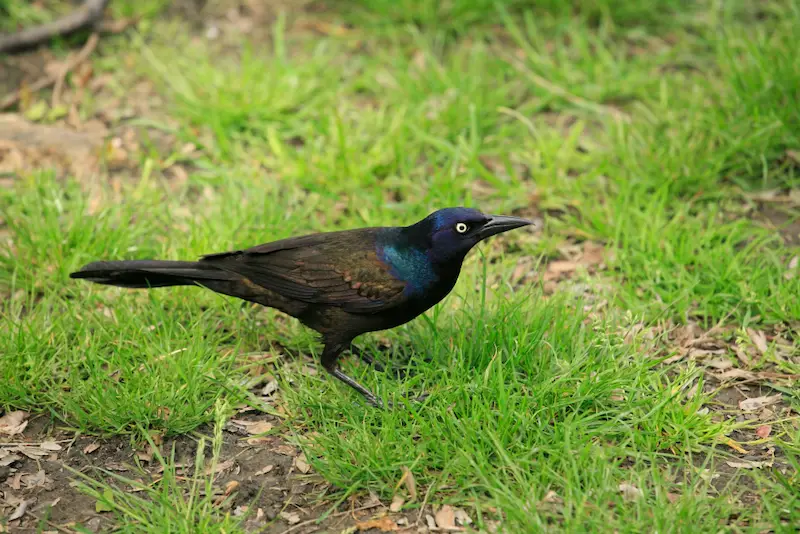
From a distance, a Common grackle seems to be an entirely black-colored bird, making it easy to confuse it with a crow, which is also entirely black.
But in contrast to a crow, the Common Grackle has a pointed beak that is formed like a cone, as well as eyes that are bright yellow, and a long tail that is shaped like a wedge.
In south North Carolina, this bird lives in open spaces such as meadows, parks, and fields, as well as suburban and residential regions
Male Common Grackles have shimmering purple coloration on the black feathers of their heads, breasts, and necks, as well as other parts of their bodies.
During the nesting season, the females construct large nests in which they will lay a clutch of about five eggs.
In northern parts of its range, the Common Grackle is a migratory summer visitor, but in North Carolina it can be found year round.
This bird is a member of the New World family of blackbirds, which contains some of the most common birds in North America, many of which like to gather in large flocks and make a lot of noise.
On farms, Common Grackles can congregate in huge flocks to feed on crops and grain, and to roost, which can cause a problem to North Carolina farmers.
Because this bird is such a versatile species, the Common Grackle can thrive in many different environments.
Red-bellied Woodpecker
Scientific name: Melanerpes carolinus
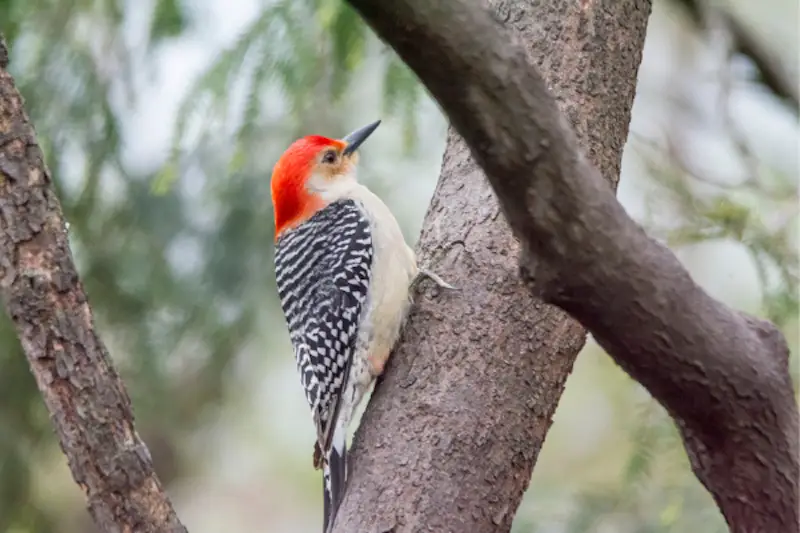
The Red-bellied Woodpecker has a black-and-white “Zebra” pattern on its back, as well as a white rump.
Its red crown goes all the way down to the base of the neck. Both sexes look similar, although the female has a partially gray crown.
The Red-bellied Woodpecker favors shady woodlands, forest edges and backyards with old trees.
This bird excavates holes in rotting wood to locate beetles, centipedes, spiders, and other creatures.
During winter, this bird stores berries and acorns in tree crevices and cracks. Every year, the Red-bellied Woodpecker excavates a new nest below the previous one in the same tree.
While this bird is named for the reddish tinge on its belly, this can be hard to see unless you get a close up view.
Fortunately, this beautiful red headed bird is steadily expanding its range across the whole country.
Downy Woodpecker
Scientific name: Picoides pubescens

The Downy Woodpecker is the smallest woodpecker found in North Carolina.
While males are black and white with a small red patch on their nape, females are entirely black and white.
The wings of both sexes are black with white feathers, which look like spots when the wings are folded.
Downy Woodpeckers are non-migratory, and can be seen all year round throughout North America, except for the arid regions in southern states.
You can tell this woodpecker apart from the Hairy Woodpecker by its smaller size and short bill.
While Downy Woodpeckers don’t migrate, they like to move around outside of the breeding season, in search of areas with plentiful food.
Their preferred habitat is deciduous or mixed forest, where they feed on insects and insect larvae found under the bark of trees. During winter they also eat berries and seeds.
Hairy Woodpecker
Scientific name: Picoides villosus

The Hairy Woodpecker looks similar to the Downy Woodpecker, but has a longer, thicker bill, and is a much larger bird overall.
Both the male and the female have black upperparts with white bars on the wing feathers, which look like spots when the wings are folded.
The male has a very small red patch on the back of its head, which is considerably smaller than the red patches on other woodpecker species.
The Hairy Woodpecker is a common breeding bird found throughout North America, and can be seen in North Carolina year-round.
This woodpecker breeds in both coniferous and deciduous forests, and is even found in parks and other urban areas with trees.
Carolina Wren
Scientific name: Thryothorus ludovicianus

The Carolina Wren is a common little garden bird with chestnut brown upperparts and creamy white underparts. Wings and tails have dark brown barring.
Males and females look alike, as do young individuals. The Carolina Wren is a non-migratory species, and can be spotted all year round in the state of North Carolina.
It is a familiar small bird, which can be found in North Carolina backyards, scrubland, and forests. It feeds mostly on insects and other small invertebrates.
Ruby-throated Hummingbird
Scientific name: Archilochus colubris
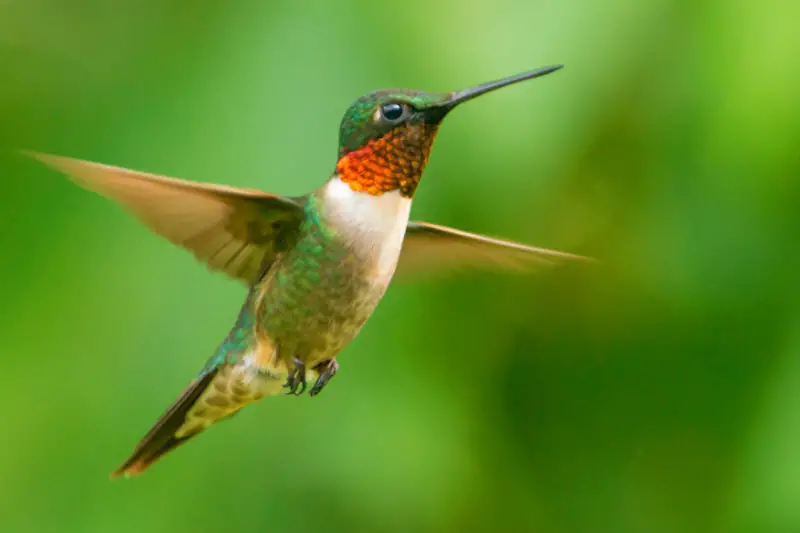
The Ruby-throated Hummingbird is the most common Hummingbird in North Carolina. Weighing just 0.1 ounces, it is truly a tiny songbird compared to other species.
The male has a black throat that reflects flashes of ruby red when it catches the sunlight.
Similar to other Hummingbirds, this bird can fly straight up, down, or backwards, and can also hover in mid air, with its wings generating a humming sound like a tiny generator.
Hummingbirds are fascinating creatures that breathe up to 250 times per minute and have a heartbeat of over 1,200 times per minute.
The Ruby-throated Hummingbird is attracted to gardens and backyards that have tubular flowers that produce a lot of nectar.
In addition to flower nectar, this bird also feeds on insects. It is a long-distance migrant, and spends its winter in Central America.
House Wren
Scientific name: Troglodytes aedon
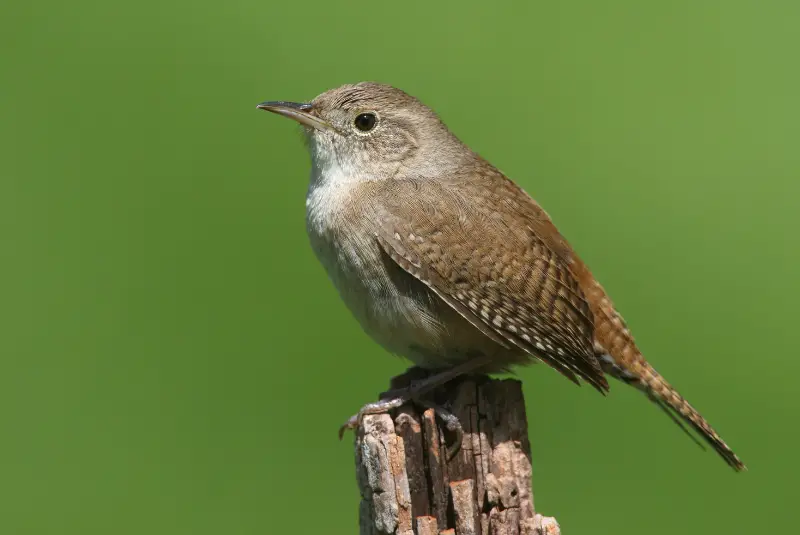
The House Wren is a small songbird with a relatively long beak. Compared to other wrens, this bird has a long tail, which it likes to cock up.
At a distance, House Wrens resemble uniformly brown birds, but when viewed close up, you can discern subtle barring on their wings and tail.
In contrast to the Carolina Wren, which is a year-round resident in North Carolina, the House Wren is a winter visitor in North Carolina, where it winters from September through April.
Yellow-rumped Warbler
Scientific name: Setophaga coronata

While the sexes of the Yellow-rumped Warbler are dissimilar, they both have a yellow rump.
This warbler exists in several variations, and the eastern population that can be found in North Carolina are also called “Myrtle Warblers”.
These small birds have blueish-gray upperparts with dark streaks, as well as a yellow rump and yellow flanks.
The Yellow-rumped Warbler is a winter visitor in North Carolina, where it can be seen from August through April.
Eastern Phoebe
Scientific name: Sayornis phoebe

The Eastern Phoebe is a plump small flycatcher with mostly gray colored plumage. The wings are slightly darker with blackish primarie and two light gray wing bars.
Both sexes, as well as juvenile birds, look very similar and have buff white underparts. This bird hunts flying insects from a perch, and catches them in flight.
This bird is a winter visitor in North Carolina that can be seen wintering in parks, backyards and woodlands from September to March.
Gray Catbird
Scientific name: Dumetella carolinensis
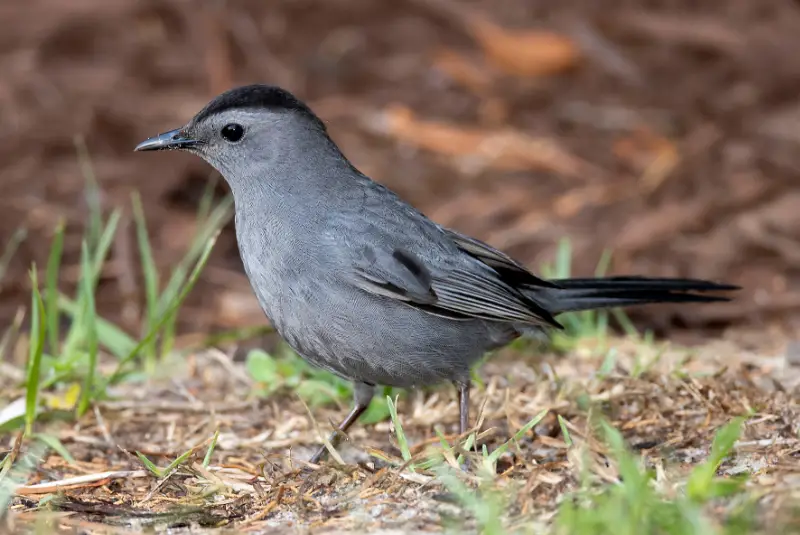
The Gray Catbird is easily recognizable due to its long tail. Both sexes and juvenile birds look alike and have dark gray body coloration, a black cap and a rufous red undertail.
The Gray Catbird is a scarce breeding bird in North Carolina, but its numbers increase during the cold season, due to large numbers of migratory catbirds that winter in the Old North state.
They like to forage for insects and berries on the ground, and can be found in forests and scrubland.
They are secretive small birds that are hard to observe.
Tufted Titmouse
Scientific name: Baeolophus bicolor
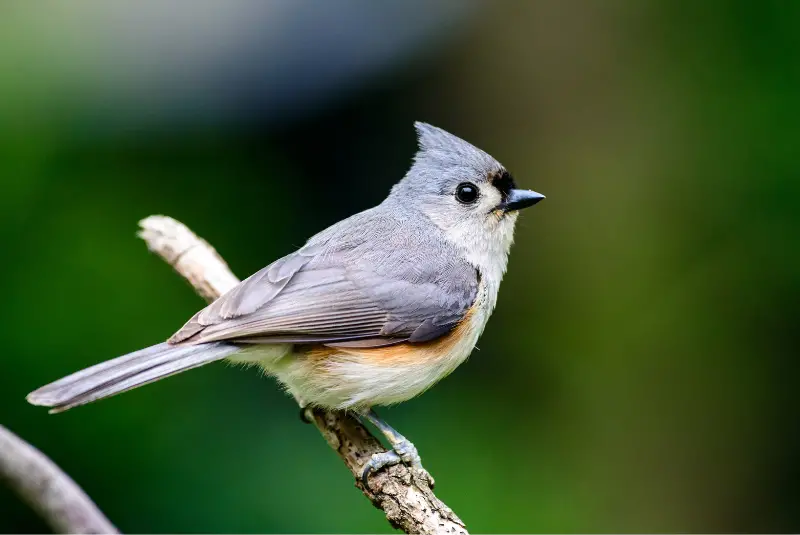
The Tufted Titmouse is a common and easily recognizable small songbird thanks to the distinctive crest on its head.
The sexes resemble each other, and have grayish-blue upperparts with a black forehead and a crest on the back of their head. The underparts are pale gray, but the flanks are tinged with buff orange.
These birds live in North Carolina all year, and are readily observed, since they aren’t very shy. They are common visitors at backyard feeders, and also breed in nestboxes.
This bird prefers deciduous forests, as well as parks and backyards, where this bird feeds on small invertebrates and seeds.
Barn Swallow
Scientific name: Hirundo rustica
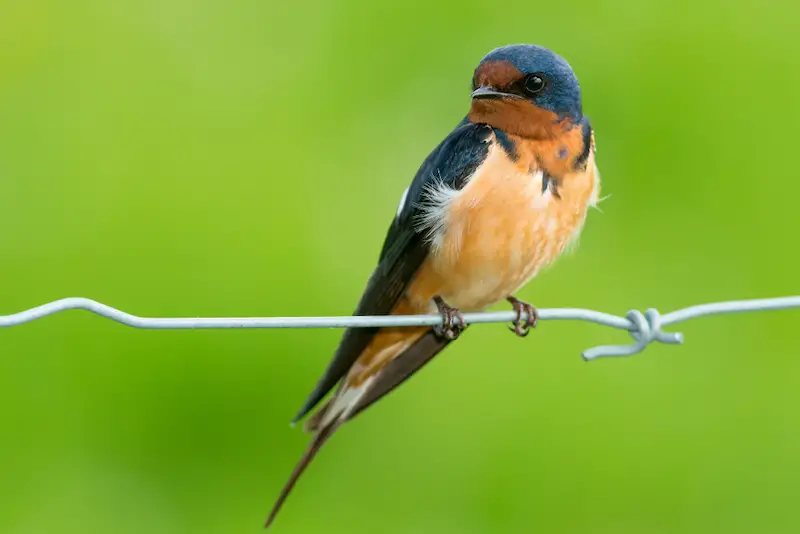
The Barn Swallow inhabits nearly all of North America south of the Arctic circle and may be found in a wide variety of habitats.
It has iridescent blue upperparts that shimmer in various shades of dark blue when the sunlight hits them.
Its underside is reddish-orange, including a chestnut orange forehead and throat, as well as a light reddish-orange belly.
The deeply forked tail of Barn Swallows is another great feature you can use to identify this blue bird.
However, keep in mind that immature barn swallows have a duller plumage than adults, as well as a shorter tail that is less forked.
The Barn Swallow used to nest in caves and hollow trees, but nowadays it prefers to do so beneath the overhangs of buildings and bridges, as well as inside barns (which explains how it got its name).
These birds are the most common swallows in North Carolina. However, the overall numbers of Barn Swallows have been steadily decreasing, especially in the northern section of their range.
This decline is likely a result of the loss of foraging areas and nesting opportunities.
The Barn Swallow feeds on flying insects, such as mosquitoes and flies, and catches them closer to the ground than other species of swallows. In its winter quarters it also feeds on termites.
It is a strictly migratory bird, and spends the winter in Central and Southern America.
Yellow-throated Warbler
Scientific name: Setophaga dominica

The Yellow-throated Warbler is easily identifiable by its vibrant yellow throat, which contrasts with black-and-white head markings and a blueish gray back.
While Yellow-throated Warblers rarely visit feeders, you can still attract them to your backyard by planting native shrubs and trees that provide a suitable foraging habitat for these birds.
Yellow-throated Warblers are year-round residents in North Carolina, where they nest in deciduous woodlands. But they can be hard to observe, since they mostly forage in treetops.
Eastern Towhee
Scientific name: Pipilo erythrophthalmus
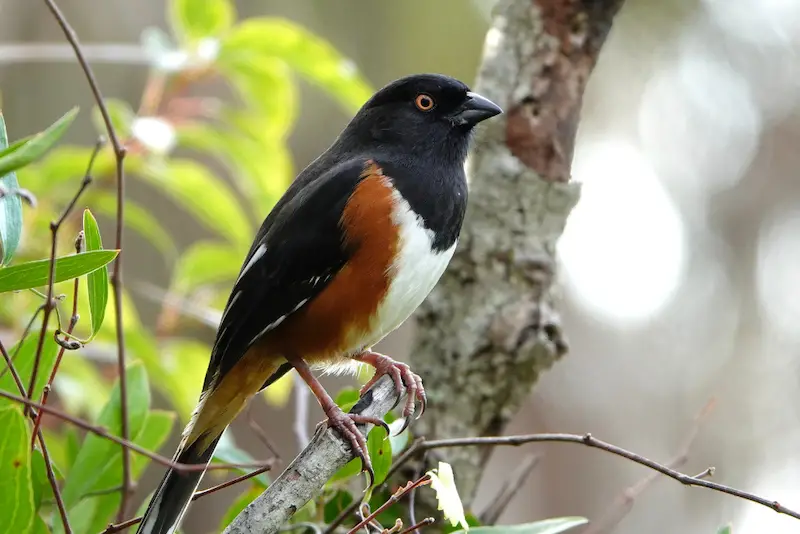
Towhees got their name from the characteristic “Tow-hee” cry that both genders use.
While Towhees don’t belong to the blackbird family, male Eastern Towhees are largely black, with rusty-brown sides and a white underside.
However, the back and head of this bird are completely black, and depending on your viewing angle, it can look entirely black.
When the Eastern Towhee takes to the air, white comma-shaped wing patches become visible on the upper side of its wings.
North Carolina is home to the red-eyed form of this species, which can be found year-round in the Old North state.
Although the female incubates the eggs until they hatch, the male does the heavy lifting when it comes to feeding the young.
The Eastern Towhee, similar to all other species of towhee, forages by making a comical backwards hopping motion with both feet at the same time.
It does this in order to displace leaves and expose the seeds and insects that are concealed under them.
You can readily attract these little birds to your feeder with black oil sunflower seeds.
Carolina Chickadee
Scientific name: Poecile carolinensis
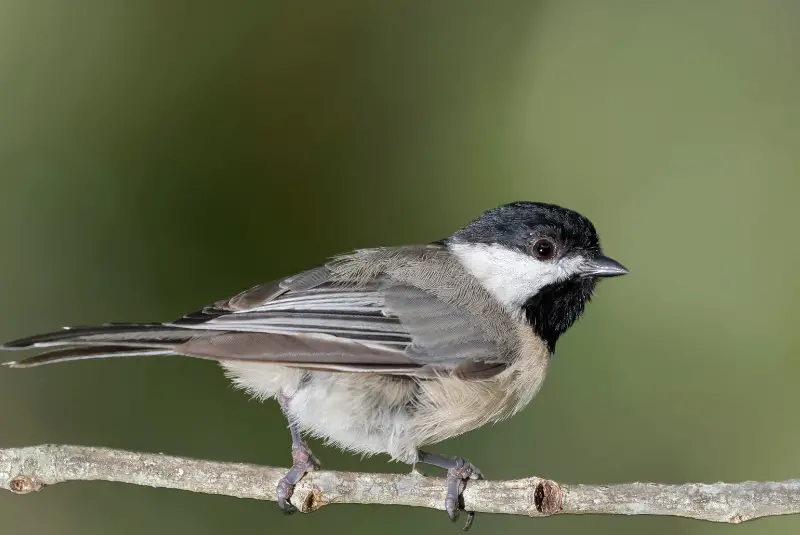
The Carolina Chickadee is easily identifiable by its black cap and black throat. Both sexes look similar and have a grayish back and buff white underparts.
The black markings on the head contrast with the bright white cheeks. This bird is a year-round resident in North Carolina, and nests in deciduous forests.
Carolina Chickadees readily visit backyard feeders, and have a preference for black oil sunflower seeds.
They also readily accept nest boxes as a substitute for treeholes, and you can get them to breed in your backyard by providing one or two of these.
Eastern Bluebird
Scientific name: Sialia sialis
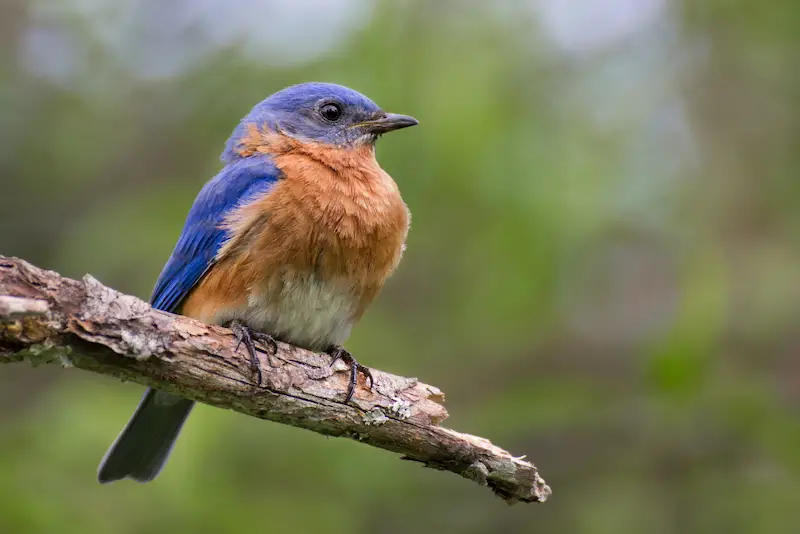
The Eastern Bluebird is a brightly colored and widespread breeding bird in the Old North state.
The upperparts of adult male Eastern Bluebirds are a rich shade of admiral blue. Their blue coloration also extends to their wings, tail, and the back of their heads.
The partial orange collar of males creates the impression of having a cap on their head. Male bluebirds have a prominent orange chest, with shades of warm-toned rufous brown.
The upperparts of adult females have a more grayish-brown color. However, females also have blue tail feathers and wing feathers, as well as a rufous-orange chest and flanks.
It is a migratory bird in the northern part of its range, but can be seen year-round in the southern part of the United States. Northern populations winter in Mexico.
The Eastern Bluebird nests in holes, and competes with House Sparrows and European Starlings for nesting sites.
During their fall migration, they can be seen in flocks that like to feed on fruits and berries.
The population of Eastern Bluebirds underwent a dramatic decline at the end of last century, due to lack of nesting holes and competition with European Starlings.
But largely thanks to the efforts of numerous North Carolina citizens providing nest boxes for Eastern Bluebirds, these beautiful birds are a common sight once more.
Indigo Bunting
Scientific name: Passerina cyanea
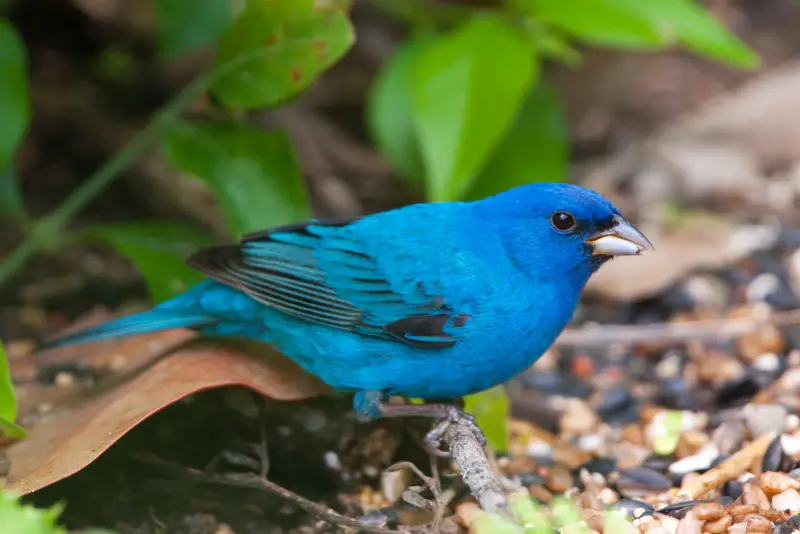
The Indigo Bunting is a brightly colored small finch. During the summer, the male is almost entirely indigo blue, except for darker brownish wingtips and tail feathers.
Females and juvenile birds are more inconspicuous, with light brown upperparts, and creamy white underparts.
The Indigo Bunting is a relatively common bird in North Carolina found at forest edges, weedy gardens and parks, and will readily visit bird feeders that offer seeds.
This is the most common blue bird found in North Carolina
This blue bird is most commonly seen at bird feeders in spring, as it switches over from seeds to eating mostly insects during the summer.
During the breeding season, males can often be observed singing from a treetop perch.
This blue bird is a strict migratory bird, and is only found in North Carolina during the summer. It winters in Central and South America, and migrates in small flocks during the fall migration.
White-throated Sparrow
Scientific name: Zonotrichia albicollis
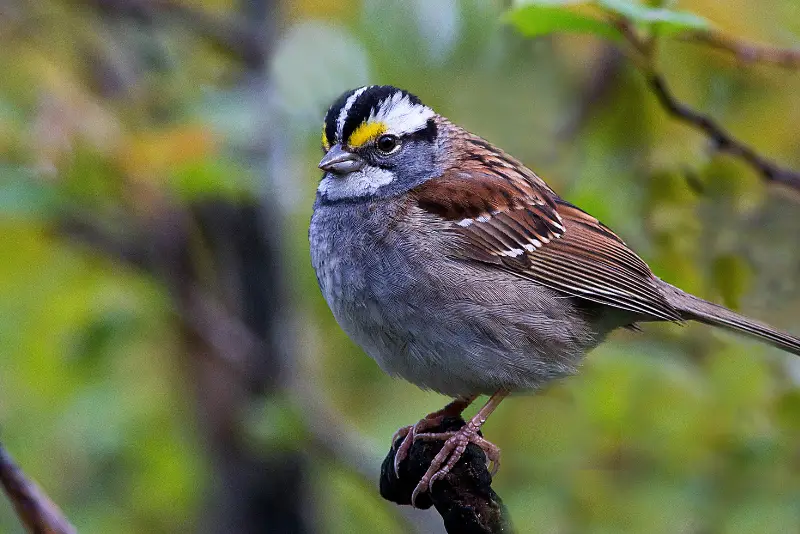
The White-throated Sparrow is a common woodland bird found in the forests of northern North America, and occurs as a common winter visitor throughout North Carolina.
Both males and females have similar appearance, featuring a brown-streaked back, rufous-brown wings with a couple white wingbars, as well as a grayish tail and a gray stripe on top of their head.
These sparrows breed from April to August in the northern forests that border on marshes and wetlands. They migrate south in the fall, and winter in large numbers in the southeastern USA
White-throated Sparrows form large flocks outside of the breeding season, and are common visitors at North Carolina bird feeders in the winter.
Dark-eyed Junco
Scientific name: Junco hyemalis

Dark-eyed Juncos are small gray-colored sparrows that are common breeding birds in the mountains of North Carolina. They can also be seen in other parts of the state during winter.
Male juncos are gray with a white belly, while females and immature birds are duller and browner.
These birds breed in coniferous as well as mixed forests of western North Carolina and during winter they can be found in a variety of habitats, including backyards, forests, and meadows.
They feed on seeds which they pick up from the ground, and can be easily recognized by the high pitched sounds they make while foraging.
White-breasted Nuthatch
Scientific name: Sitta carolinensis
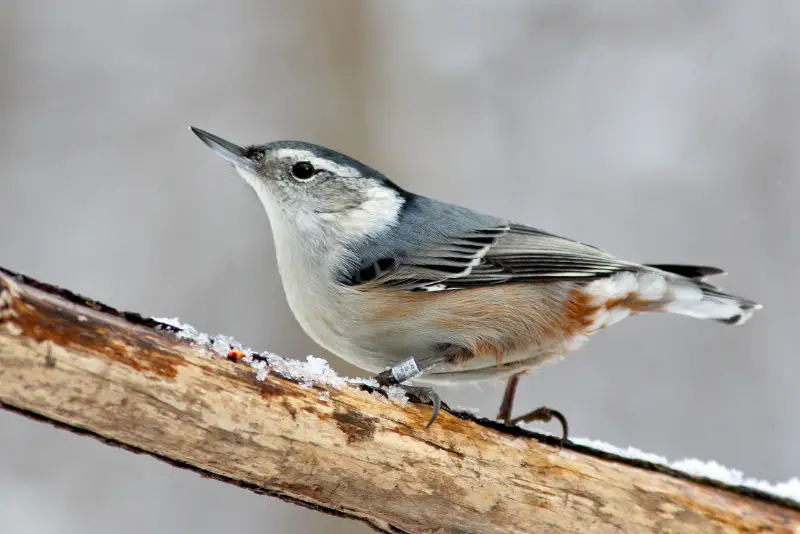
This is the largest Nuthatch species in North America, and is a common year-round resident in North Carolina.
Adults have a grayish blue back and wings, as well as a white face, throat, and breast.
These birds favor deciduous or mixed forests, and are common visitors at tube feeders in North Carolina offering sunflower seeds.
Outside of the breeding season White-breasted Nuthatches form small flocks with other species of songbirds, which rove around in North Carolina and forage together.
Song Sparrow
Scientific name: Melospiza melodia
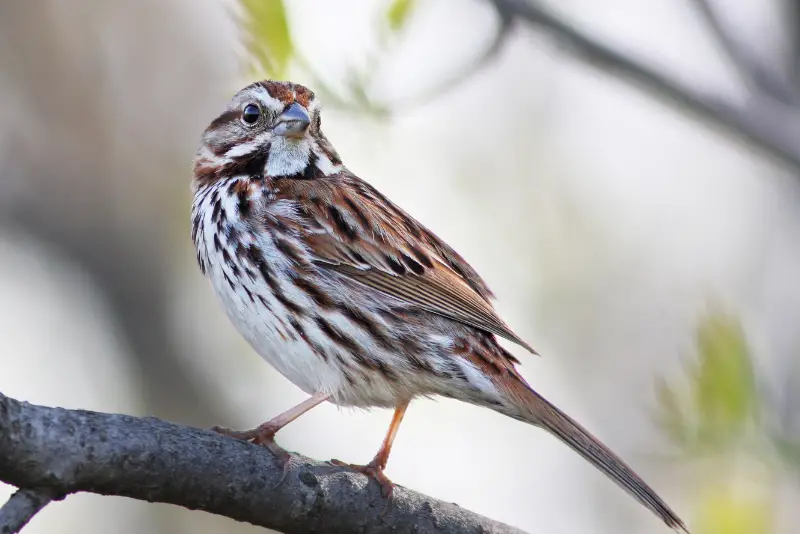
The Song Sparrow is an inconspicuous little brown bird, but can be recognized by its dark breast markings that merge into a central black spot.
The back is reddish brown with dark brown streaks, and the reddish wings have two white wingbars.
The Song Sparrow is a common summer visitor in North Carolina, where it can be seen from April to October.
It spends the winter in more southern states, and also in Mexico. Song Sparrows prefer fields and meadows with scrubs and dense bushes.
Chipping Sparrow
Scientific name: Spizella passerina
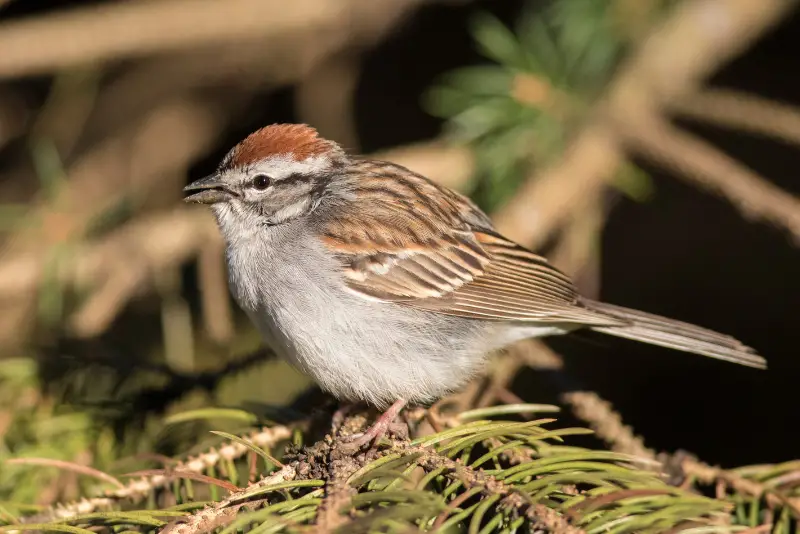
The Chipping Sparrow is a common bird in many man made habitats, including backyards, gardens, and parks.
Adult birds can be recognized by their chestnut crown, which contrasts with a white supercilium (or eyebrow stripe) and black eye stripe.
The Chipping Sparrow is a widespread and common breeding bird in North Carolina, where it can be seen as a summer visitor from May through October.
These birds migrate south and spend the winter in the southern USA, as well as Mexico and Central America.
What are the top 5 most common birds in North Carolina?
The top 5 most common birds in North Carolina are:
- Northern Cardinal
- Carolina Wren
- Carolina Chickadee
- Tufted Titmouse
- American Crow
Out of these 5 species, the Northern Cardinal is the most frequently seen bird in North Carolina, and is reported in 59% of eBird checklists submitted for North Carolina.
So if you spot a red-colored bird while bird watching in the Old North state, this is the first species to check for.
And while all of these birds are familiar backyard birds of North Carolina, they can also be found in remote areas.
How can you attract North Carolina birds to your yard?
The top 5 things you can do to get North Carolina birds to visit your backyard are as follows:
- Set up a feeder with sunflower seeds, or a seed mix
- Set up a bird bath
- Plant shrubs to provide nesting opportunities
- Plant native fruiting plants to provide foraging opportunities
Tip: if you want to attract Eastern Bluebirds to your backyard feeder, it’s best to offer mealworms, since they’re not interested in seeds.
And if you want to attract American Robins to your feeder, offer apple slices (or other fruits), since they also don’t eat seeds.
If you enjoyed this article, check out our guide to the herons of North Carolina.
